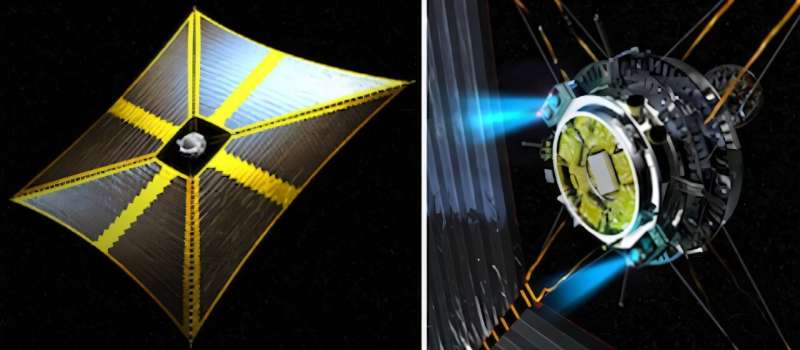
Getting a mission to the point of officially being accepted for launch is an ordeal. However, even when they aren’t selected for implementation, their ideas, and in some cases, their technologies, can live on in other missions. That was the case for the Oversize Kite-craft for Exploration and AstroNautics in the Outer Solar system (OKEANOS) project, originally planned as a Japanese Aerospace Exploration Agency (JAXA) mission.
Despite not receiving funding to complete its entire mission, the project team released a paper that details the original plan for the mission, and some of those plans were incorporated into other missions that are still under development.
OKEANOS sought to build on JAXA’s success in returning samples from asteroids to Earth. Its most well-known mission in that regard was Hayabusa-2, which returned samples from the asteroid Ryugu in 2020 and has been the subject of dozens of scientific papers since. Ryugu is a near-Earth asteroid, which means its origins in the solar system are dramatically different from those of other asteroids farther out from the sun, which is where OKEANOS came in.
The original plan for OKEANOS was to launch a sample return mission to one of the Jupiter Trojan asteroids that sit in the Lagrange points in front of and behind Jupiter and its orbital path. Scientists believe these asteroids originated outside of Neptune’s orbit in the Kuiper belt but were brought closer to the sun due to gravitational fluctuations caused by the migration of the gas giant planets.
Since they would hold clues to the early solar system, astronomers are interested in their composition, and some space exploration enthusiasts are interested in the materials they hold for in-situ resource utilization purposes. But so far, no missions have visited them yet.
That is about to change, though, with Lucy, a NASA mission that launched in 2021 to visit them. However, Lucy will simply do remote observations and lacks the equipment to sample them directly, let alone return a sample back to Earth. The project team had hoped OKEANOS would do just that.
Several novel technologies would be used to enable OKEANOS’ scientific objectives. One of the most interesting was a combination solar sail and ion drive known as a solar power sail. A solar power sail combines the solar pushing power of a solar sail with flexible photovoltaic solar collectors that can collect a significant amount of energy while deployed in a sail-like configuration. JAXA has also successfully tested a similar system with its IKAROS mission, demonstrating the technology in 2010.
Since solar sails have tiny thrust out near Jupiter, OKEANOS relies entirely on an ion engine and simply deploys its “sails” to deploy the solar panels that collect energy to power the ion drive. But once it reached its destination, it would utilize its second interesting technology—a lander.
The two main asteroid sample return missions—OSIRIS-REx and Hayabusa-2—directly touched down on the surface of their respective asteroids. However, there have been deployed landers that have at least attempted to land on an asteroid before—Philae, the lander that accompanied ESA’s Rosetta mission, is probably the most famous.
But never before has a mission attempted to land a lander, collect a sample, and return it to a “mothership” that would then transport that sample back to Earth. Doing so out at the Trojan asteroids would add a new difficulty level of having significant communications lag time, making it difficult to troubleshoot any problems with the mission.
Discover the latest in science, tech, and space with over 100,000 subscribers who rely on Phys.org for daily insights.
Sign up for our free newsletter and get updates on breakthroughs,
innovations, and research that matter—daily or weekly.
Given JAXA’s track record, it seemed likely that they could pull off that technical challenge. However, the mission was never fully funded due to a “cost issue,” according to the paper. JAXA selected a project known as LiteBIRD to study the cosmic microwave background as its large-class mission for this decade instead.
Despite that, the technical details of some of the instrumentation have been described in other papers, and the project team feels confident that future asteroid sample return missions will adopt at least some of them. We’ll be sure to see more of those in the future as interest grows in understanding the roots of our solar system and how we might utilize the readily available resources on asteroids.
Details were published in 2023 in the journal Acta Astronautica.
Journal information:
Acta Astronautica
Provided by
Universe Today
OKEANOS—A mission that would have returned samples from the Trojan asteroids (2024, November 26)
retrieved 26 November 2024
from https://phys.org/news/2024-11-okeanos-mission-samples-trojan-asteroids.html
part may be reproduced without the written permission. The content is provided for information purposes only.